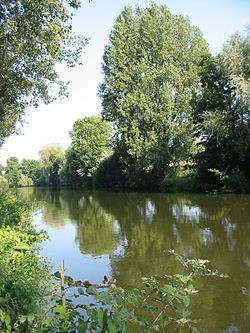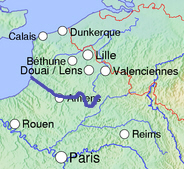Somme (river)
You can helpexpand this article with text translated fromthe corresponding articlein French.Click [show] for important translation instructions.
|
| Somme | |
|---|---|
 The Somme | |
 Course in Northern France | |
| Location | |
| Country | France |
| Region | Picardy |
| Physical characteristics | |
| Source | |
| • location | Fonsommes |
| • coordinates | 49°54′23″N03°24′11″E/ 49.90639°N 3.40306°E |
| • elevation | 85 m (279 ft) |
| Mouth | |
• location | Saint-Valery-sur-Somme English Channel |
• coordinates | 50°11′10″N01°38′35″E/ 50.18611°N 1.64306°E |
| Length | 245 km (152 mi) |
| Basin size | 6,550 km2(2,530 sq mi) |
| Discharge | |
| • location | Abbeville |
| • average | 35 m3/s (1,200 cu ft/s) |
TheSomme(UK:/sɒm/SOM,US:/sʌm/SUM,[1][2]French:[sɔm]) is ariverinPicardy,northernFrance.
The river is 245 km (152 mi) in length, from its source in the high ground of the formerArrouaise ForestatFonsommenearSaint-Quentin,to theBay of the Somme,in theEnglish Channel.It lies in thegeologicalsynclinewhich also forms theSolent.This gives it a fairly constant and gentle gradient where severalfluvial terraceshave been identified.[3]
Name[edit]
The Somme river was known in ancient times asSamara.It presumably means 'the summery river', that is to say the 'quiet river', stemming from an adjective *sam-aro- ('summery') itself derived from theCelticroot *samo- ('summer').[4][5]
The city ofAmienswas also known asSamarobriva(Gaulish: 'bridge on the Samara'). It is attested by the early 1st century BC as the chief town of theAmbiani,an ancientGallictribe of the region.[5]The modern department ofSommewas named after this river.
History[edit]

The Somme has featured prominently in several military campaigns. In 1066, the invasion fleet ofWilliam the Conquerorassembled in the Bay of the Somme, atSaint-Valery-sur-Somme.The river also featured in the 1346 withdrawal ofEdward III of England's army, which forded the river at theBattle of Blanchetaqueduring the campaign, which culminated in theBattle of Crécy.Crossing the river also featured prominently in the campaign which led to theBattle of Agincourtin 1415.
In 1636, a Spanish army led byThomas Francis, Prince of Carignano,crossed the Sommedefeating a French army during theThirty Years Warthreatening Paris.[6]
Most famously, theBattle of the Somme,duringWorld War I,lasted from July to November 1916 and resulted in more than a million casualties. Private A. S. Bullock in his wartime memoir recalled his first sight of it in early April 1918: "... we reached a small place calledHengest sur Somme.The train stopped and we descended. There in front of us was a muddy, sluggish and somewhat narrow stream, which has given its name to one of the most awful battles in history – the Somme. "[7]The great battles that finally stopped the German advance in theSpring Offensiveof 1918 were fought around the valley of the Somme in places likeVillers Bretonneux,which marked the beginning of the end of the war.

Départements and towns along the river[edit]



Tributaries[edit]
The tributaries listed comprise:
|
left tributaries: |
right tributaries: |
Hydrology[edit]
The river is characterized by a very gentle gradient and a steady flow. The valley is more or less steep-sided but its bottom is flat withfensand pools. These characteristics of steady flow and flooded valley bottom arise from the river's being fed by theground waterin thechalkbasin in which it lies. At earlier, colder times, from theGünzto theWürm(Beestonian or Nebraskan to Devensian or Wisconsinian) the river has cut down into theCretaceousgeology to a level below the modernwater table.The valley bottom has now therefore, filled with water which, in turn, has filled withfen.This picture,of the source of the Somme in 1986, shows it when the water table had fallen below the surface of the chalk in which theaquiferlies. Here, the flow of water had beensufficientto keep fen from forming.
This satellite photographshows the fenny valley crossing the chalk to the sea on the left. The sinuous length at the centre of the picture lies downstream fromPéronne.
One of the fens, theMarais de l'Îleis a nature reserve in the town of St.Quentin. The traditional market gardens ofAmiens,theHortillonagesare on this sort of land but drained. Once exploited forpeat cutting,the fen is now used for fishing and shooting
In 2001, the Somme valley was affected by particularly high floods, which were in large part due to a rise in thewater tableof the surrounding land.
Flow-rate data (external links)[edit]
Monthly flow rates[edit]
Catchment area 5,560 km2(2,150 sq mi).
Flow rates at Hangest-sur-Somme[edit]
Daily flow rates compared with mean rates for the time of year at Hangest-sur-Somme (m³/s). Catchment area 4,835 km2(1,867 sq mi).
- for the year -
1993.1995.1997.1998.1999.2001.2003.2005.
Flow rates at Péronne[edit]
Mean flow rates monthly and daily at Péronne (m³/s). Catchment area 1,294 km2(500 sq mi).
- for the year -
1987.1989.1991.1992.1993.
1995.1996.1997.1999.2000.2001.2002.2003.2004.2005.

[edit]
The construction of theCanal de la Sommebegan in 1770 and reached completion in 1843. It is 156 km (97 mi) long, beginning at St.Simon and opening into the Bay of the Somme. From St.Simon to Froissy (near Bray sur Somme, south of Albert), the canal is alongside the river. Thence to the sea, the river is partly river and partly navigation. FromAbbeville,it is diverted through thesilted,formerestuary,toSaint-Valery-sur-Somme,where the maritime canal, once called the canal du Duc d'Angoulême enters the English Channel.

TheSt Quentin Canal,famous for the1918 battle,links the Somme to northern France andBelgiumand southward to theOise.TheCanal du Nordalso links the Somme to the Oise, at Noyon, thence to Paris.
References[edit]
Citations[edit]
- ^Wells, John C.(2008).Longman Pronunciation Dictionary(3rd ed.). Longman.ISBN978-1-4058-8118-0.
- ^Jones, Daniel(2011).Roach, Peter;Setter, Jane;Esling, John(eds.).Cambridge English Pronouncing Dictionary(18th ed.). Cambridge University Press.ISBN978-0-521-15255-6.
- ^Gargani J.; Stab O; Cojan I.n Brulhet J. (2006). "Modelling the long-term fluvial erosion of the river Somme during the last million years".Terra Nova.18(2): 118–129.Bibcode:2006TeNov..18..118G.doi:10.1111/j.1365-3121.2006.00671.x.S2CID130418864.
- ^Matasović 2009,p. 321.
- ^abFalileyev 2010,s.v.SamaraandSamarobriva Ambianorum.
- ^Hanotaux, Gabriel (1933–1947).Histoire du cardinal de Richelieu(in French). Vol. 5. Paris. 319–21, 327.
{{cite book}}:CS1 maint: location missing publisher (link) - ^Bullock, Arthur Stanley (2009).Gloucestershire Between the Wars: a memoir.Stroud: The History Press.ISBN9780752447933.
Sources[edit]
- Delattre, Ch., Mériaux, E. and Waterlot, M.Guides Géologiques Régionaux: Région du Nord, Flandre Artois Boulonnais Picardie(1973)
- Falileyev, Alexander (2010).Dictionary of Continental Celtic Place-names: A Celtic Companion to the Barrington Atlas of the Greek and Roman World.CMCS.ISBN978-0955718236.
- Matasović, Ranko(2009).Etymological Dictionary of Proto-Celtic.Brill.ISBN9789004173361.
